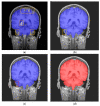Dimensionality Reduction Hybrid U-Net for Brain Extraction in Magnetic Resonance Imaging
- PMID: 38002509
- PMCID: PMC10669566
- DOI: 10.3390/brainsci13111549
Dimensionality Reduction Hybrid U-Net for Brain Extraction in Magnetic Resonance Imaging
Abstract
In various applications, such as disease diagnosis, surgical navigation, human brain atlas analysis, and other neuroimage processing scenarios, brain extraction is typically regarded as the initial stage in MRI image processing. Whole-brain semantic segmentation algorithms, such as U-Net, have demonstrated the ability to achieve relatively satisfactory results even with a limited number of training samples. In order to enhance the precision of brain semantic segmentation, various frameworks have been developed, including 3D U-Net, slice U-Net, and auto-context U-Net. However, the processing methods employed in these models are relatively complex when applied to 3D data models. In this article, we aim to reduce the complexity of the model while maintaining appropriate performance. As an initial step to enhance segmentation accuracy, the preprocessing extraction of full-scale information from magnetic resonance images is performed with a cluster tool. Subsequently, three multi-input hybrid U-Net model frameworks are tested and compared. Finally, we propose utilizing a fusion of two-dimensional segmentation outcomes from different planes to attain improved results. The performance of the proposed framework was tested using publicly accessible benchmark datasets, namely LPBA40, in which we obtained Dice overlap coefficients of 98.05%. Improvement was achieved via our algorithm against several previous studies.
Keywords: U-Net; brain extraction; magnetic resonance imaging (MRI); semantic segmentation; whole-brain segmentation.
Conflict of interest statement
The authors declare that there are no conflict of interest regarding the publication of this paper.
Figures











Similar articles
-
Auto-Context Convolutional Neural Network (Auto-Net) for Brain Extraction in Magnetic Resonance Imaging.IEEE Trans Med Imaging. 2017 Nov;36(11):2319-2330. doi: 10.1109/TMI.2017.2721362. Epub 2017 Jun 28. IEEE Trans Med Imaging. 2017. PMID: 28678704 Free PMC article.
-
An investigation of the effect of fat suppression and dimensionality on the accuracy of breast MRI segmentation using U-nets.Med Phys. 2019 Mar;46(3):1230-1244. doi: 10.1002/mp.13375. Epub 2019 Feb 4. Med Phys. 2019. PMID: 30609062
-
3D U-Net Improves Automatic Brain Extraction for Isotropic Rat Brain Magnetic Resonance Imaging Data.Front Neurosci. 2021 Dec 16;15:801008. doi: 10.3389/fnins.2021.801008. eCollection 2021. Front Neurosci. 2021. PMID: 34975392 Free PMC article.
-
A multiple-channel and atrous convolution network for ultrasound image segmentation.Med Phys. 2020 Dec;47(12):6270-6285. doi: 10.1002/mp.14512. Epub 2020 Oct 18. Med Phys. 2020. PMID: 33007105
-
EG-Unet: Edge-Guided cascaded networks for automated frontal brain segmentation in MR images.Comput Biol Med. 2023 May;158:106891. doi: 10.1016/j.compbiomed.2023.106891. Epub 2023 Apr 3. Comput Biol Med. 2023. PMID: 37044048 Review.
References
-
- Jenkinson M., Pechaud M., Smith S. BET2: MR-based estimation of brain, skull and scalp surfaces; Proceedings of the 11th Annual Meeting of the Organization for Human Brain Mapping; Toronto, ON, USA. 12–16 June 2005; p. 167.
-
- Qiu J., Cheng W. Brain tissues extraction based on improved brain extraction tool algorithm; Proceedings of the 2016 2nd IEEE International Conference on Computer and Communications (ICCC); Chengdu, China. 14–17 October 2016; pp. 553–556.
-
- Luo Y., Gao B., Deng Y., Zhu X., Jiang T., Zhao X., Yang Z. Automated brain extraction and immersive exploration of its layers in virtual reality for the rhesus macaque MRI data sets. Comput. Animat. Virtual Worlds. 2019;30:e1841. doi: 10.1002/cav.1841. - DOI
-
- 3dSkullStrip, a Part of the AFNI (Analysis of Functional Neuro Images) Package. [(accessed on 1 December 2021)]; Available online: http://afni.nimh.nih.gov.
Grants and funding
LinkOut - more resources
Full Text Sources
Research Materials

